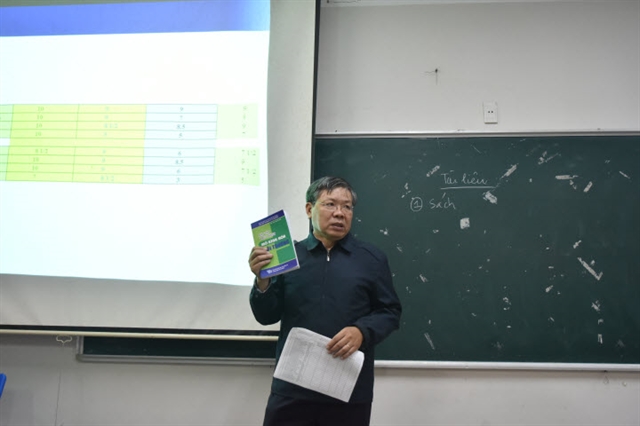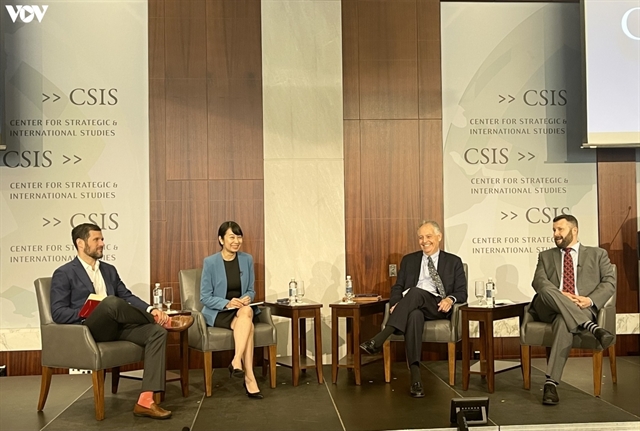 Opinion
Opinion


|
| Assoc. Prof. and Dr Nguyễn Thị Lan Anh, Director of the East Sea Institute under the Diplomatic Academy of Việt Nam (second) at the 13th annual conference on the East Sea in Washington held by the Centre for Strategic and International Studies (CSIS). — Photo vov.vn |
HÀ NỘI — Closer cooperation and greater transparency among ASEAN members, especially those with direct interests in the East Sea (known internationally as South China Sea), might be helpful in countering grey-zone tactics in this important strategic waterway, according to maritime security experts in the region.
Grey-zone operations – including but not limited to harassing of fishing boats, deployments of survey ships and drilling platforms and maritime law enforcement vessels in the exclusive economic zones of other countries, while not constituting full-blown acts of war, infringe upon international law and put lives at risk and raise tensions.
Dr Collin Koh, Senior Fellow at the Institute of Defence and Strategic Studies of the S. Rajaratnam School of International Studies, based in Nanyang Technological University, Singapore, said grey zone is a manifestation of statecraft, rather than reason, calling these “short of war” strategies that comprise a range of actions “under the threshold of the use of lethal kinetic force.”
Other than physical actions on the ground, the Singaporean-based international relations expert argued that the definition could be expanded to include economic coercion and political influence and subversion.
There is an obvious uptick in the cause of incidences in the Eas Sea, but given the advent of modern technology, including open-source intelligence, what relevant parties are doing on the ground are becoming more transparent, according to Collins.
Intra-ASEAN cooperation
Evan Laksmann, Senior Fellow for Southeast Asia Military Modernisation at the Asia office of the International Institute for Strategic Studies (IISS) in Singapore, said “transparency is always going to be necessary, but it's never going to be sufficient,” with regards to the Philippines’ seemingly new strategy of publicising every bad conduct from other rivals in the East Sea.
“Transparency cuts in multiple ways, not just one way, as in calling out bad behaviour, but it also highlights the lack of or the need to have a much more comprehensive strategy to respond to these broader sets of challenges. It also highlights the fact that sometimes when you do have transparency, you better have an existing policy structure in mind, a set of options in mind that you can also try to take back control of the ladder of escalation and you should be prepared to have not just military means but also diplomatic, economic, and others,” he said.
The Indonesian researcher also stressed the need for greater intra-ASEAN cooperation on these issues, and that the claimants need to really make more effort to resolve their own maritime boundary disputes between each other.
“Philippines, Malaysia, Việt Nam, and others should step away from the grey zone by clarifying your own plans and initiating maritime delimitation talks,” Evan said.
In tandem with or to complement what’s going on with the Code of Conduct of Parties (COC) in the East Sea talks (between ASEAN member States and China), the expert also urged ASEAN countries to “put more resources into intra-ASEAN maritime cooperation, make it much more closer, regardless of what happens with the COC, with more regular activities and joint training even between maritime law enforcement in ASEAN.
“There is nothing in the COC process that says that you have to wait until we complete the COC before we can start maritime delimitation talks, so while COC talks are ongoing (with the next one in Beijing), it is incumbent upon the rest of the region to consider non-COC options as well.”
Nguyễn Thị Lan Anh, Director General of the East Sea Institute, the Diplomatic Academy of Việt Nam, also agrees that there needs to be more transparency – or shed light into the grey zone.
“We need to clarify the claims along with the other claimants in the East Sea. We need to ‘transparent-ise’ all the activities that we conduct in the East Sea.”
She also argued for effective responses collectively among ASEAN as a way of countering grey-zone strategy.
She commented that the negotiations for COC had been going on for 26 years, triple the time needed to complete the negotiation process for the United Nations’ Convention on the Law of the Sea 1982 (UNCLOS 1982), which means the parties involved should think about another process – that goes alongside COC talks – with quicker progress that brings meaningful norms and rules for the countries involved to implement.
With regards to individual maritime space caught in the grey zone problem, there is no long-term solution without strategic policy ecosystem overhaul, Evan acknowledged.
“You can have all of the systems you want, you can have all of their transparency in one but if the maritime policy ecosystem is not fundamentally overhauled, the relationship between the Coast Guard and the Navy, the capacity of the Coast Guard, the centrality of a coordinated messaging and crisis communication system. I think this hinders the creation of a proactive strategy rather than a reactive response to developments on the ground.”
“So at the end of the day, I think for a long term effort to remove yourself from the grey zone situation or equation, you do need to follow through on difficult and painful domestic policy reforms around maritime security roles or strategic policy more broadly.”
External partners
Concerning the role of external partners in helping Southeast Asian nations deal with grey-zone tactics, Dr Lan Anh said since foreign powers have the freedom of navigation and freedom of overflight in the East Sea, “so engagement is their right first, but of course second, that engagement is up to our need.”
Dr Collins said other than maritime capacity building talks with partners that could include “shiny toys” (drones, radars, ships) that allow one to have maritime domain awareness and assert one’s claims at sea, there should be a broader conversation, including opening up markets.
“For example, if you don't want Southeast Asian countries to fall prey to economic coercion, such as denial of access to the market, then the only way to do that is economic diversification. But that is easier said than done,” he said, citing, for example, the fact that countries will need to tighten regulatory standards in order for their agricultural products to reach into more developed but stricter markets.
On this front, the Vietnamese scholar also took note of the need for diversification in supply chains as developed nations in the world are practising ‘friendshoring’ to ensure their supply chains. This would be an opportunity for countries in the region to join in a more sustainable way in order to prepare for any economic coercions in the future, Lan Anh said. — VNS